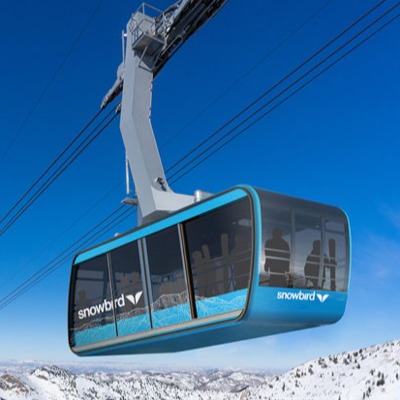Schmittenhohebahn Celebrates 95 Years

The Schmittenhöhebahn was built in 1927 and was the very first cable car in the Salzburg region. In this anniversary year, not only is the 95th birthday celebrated, but also some revision and conversion work is being carried out.
The Schmittenhöhebahn stands for both tradition and innovation. Therefore, on the one hand, the existing Porsche Design gondolas are being modified and brought up to the current state of the art, for which they were recently transported to Gmunden. On the other hand, some adjustments to the supports are necessary for the routine extension of the concession.
After this revision work, the concession will be extended and the Schmittenhöhebahn can head towards its 100th anniversary in 2027. Interesting side fact: The Porsche Design gondolas are the sixth generation of the means of transport.
In 1873 , the Austrian Alpine Club and the municipality of Zell am See built the first path to the Schmittenhöhe . At first you could only get up the mountain on foot, on horseback and in small, two-wheeled mountain carts with a seat and a view to the rear, which were pulled by mules. The construction of the cable car goes back to the Zell lawyer Dr. Edward Bittner back. In 1924 he spent his holidays in South Tyrol , where he was very impressed by the ride on the Merano -Avelengo cable car. When he returned, he decided, together with his friends Dr. Ludwig Margreiter and Leo hoststo build a cable car to the Schmittenhöhe.
On October 30, 1924 , the Federal Ministry of Trade and Transport granted the preliminary license. The groundbreaking ceremony for the construction of the valley station then took place on May 4, 1927 . And the cable car could be built in the short construction time of just 227 construction days. In the same year, on December 17th , the cable car made its first journey and after official approval, the official operating license was issued by the Ministerial Commission on December 30th, 1927 at 11 p.m. Thus, the railway opened on December 31, 1927.
On January 24, 1928 , the market town of Zell am See was elevated to the status of a town and at the same time the cable car to the Schmittenhöhe was opened in a ceremony.
At first there was no power supply to the mountain station, so the cable car was powered by an 85 hp diesel engine. Peak compensation was provided by a battery of accumulators also stationed in the mountain station. A second diesel engine of the same power was available as a reserve.
It took 15 days to pull up the suspension cable. The Hercules ropes with a diameter of 52.2 mm each weighed 40 t. The ropes were pulled through the town of Zell am See along the Schmittengraben by means of motor winches over rollers, as vehicle transport was not possible. It was not until 1937 that a 3000 volt line was laid to the mountain station, which supplied an 80 kW high-performance motor there.
Right from the start, the cable car was equipped with many safety devices, such as manoeuvre, standstill and safety brakes, mechanical travel indicator, writing speedometer, stop pushbuttons in every cabin, entrance safety and end contacts. The maximum speed of 3.5 m/s has been reduced to 1 m/s 60 m before the breakpoint. The dock had an additional auxiliary rope with which an ambulance could be brought to the cabins. The top speed was increased to 4 m/s in 1937 after the new power line was laid. In 1938 the counter cable was replaced , in 1943/44 the carrying and traction cables. The old traction rope was used to pull up the new suspension ropes.
The carriages initially offered space for 23 people + carriage attendants. In 1938 new light metal cabs for 44 people each and new traveling gear were ordered. The stations also had to be rebuilt. In 1948 , new cabins and a larger traction sheave were ordered again. The speed increased to 5 m/s. In 1955 there was a major renovation of the valley station and a new drive motor was commissioned. An anchor block weighing 106 t had to be concreted behind the mountain station, which secured the mountain station with a tension cable with a diameter of 54 mm. Drive and support heads were renewed, the driving speed could be increased to 7 m/s.
In 1966/67 , the railway was fundamentally rebuilt for 17.5 million schillings, which affected all parts of the system. In 1977 a new copying station was purchased, the driving speed could be increased to 8.5 m/s.
The original gondolas of the railway were still made of wood, the second generation silver aluminum gondolas and the third yellow. The red gondolas, which were installed in 1966, had transported around 18.7 million passengers by 2009 , covering a distance equivalent to circling the earth 17 times. On October 17, 2009, these fourth-generation red gondolas ran for the last time before they were replaced by new ones starting on December 11, 2009. Restoring the old one would have been too expensive. Therefore, the company Porsche Design Studio designed new one
In 2010 , a new valley station was built within just six months at a cost of 3.3 million euros. The administration of the Schmittenhöhebahn moved to a new building in Schüttdorf to create more space for skiers in the valley station of the Schmittenhöhebahn. Among other things, a spacious bus driveway, an information center, new checkout areas and modern toilet facilities were built there. The centerpiece, however, is the Intersport Bründl sports shop with ski rental and 300 heated and disinfected lockers in which the equipment can be stored overnight. Escalators now connect the parking lots, service area and cable cars.
The gondolas of the Schmittenhöhebahn are now (2017) in their sixth generation and have changed enormously over time: where 24 people used to be transported in one cabin, there is now space for up to 43 people. In return, the carriage time was also reduced by more than half, from 15 minutes to 6.8 minutes. Today, the gondolas leave nothing to be desired in terms of technology. The highlight is the unique Porsche design gondola, which offers a unique view of Zell am See and the mountains thanks to its all-round glazing













